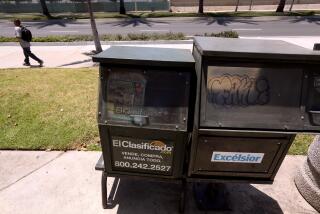As American as Appletinis
- Share via
Having spent the first 18 years of my life in Claremont, I never thought of myself as hailing from a “town.” Claremont is a city, albeit a small one, and not just because its website says so. It has a city hall, not town meetings; it boasts its own police department (which rigorously responded to the scourge of teenagers partying past 10 p.m.) and is patrolled by the L.A. County Sheriff’s Department instead of an Andy Taylor type.
Even if you don’t buy that, Claremont’s proximity to an actual big city at least qualifies it as a suburb, and it means that I can tell cloistered East Coasters and impressed foreign relatives that I grew up “near L.A.”
But this month, Money magazine declared Claremont the fifth-best “Great American Town” in the country, based on “the best combination of economic opportunity, good schools, safe streets, things to do and a real sense of community,” plus points for diversity and relatively (emphasis on the relatively) low real estate prices. Leaving aside whether Claremont deserves its high ranking (I’d argue that it does, though the teenage version of myself would whine no), I wanted to know where the magazine and I parted ways on what makes a town a town.
I’ll grant that the publication is using “town” colloquially, and not in the on-the-town sense, because some states have distinct ideas about what makes a town different from a city, and others, like California, say it’s only a name. Even so, “town” seems to refer to a tight, small community indeed, its Old English origin meant an enclosed group of homes. I expected a list full of only slightly modernized two-by-four towns small, rustic, managing to stay somewhat isolated and focused on their own population in the age of sprawl, housing booms and highways.
Instead, Money’s list is filled with suburbs and exurbs which, even if they possess “a real sense of community,” owe much of their survival and identities to nearby big cities and their former residents. Only two of the top 15 have a population in the four digits, and all of them are within 40 miles of a fair-sized city. Milton, Mass., which comes in at No. 7, is closer to Boston than several of Beantown’s better-known suburbs, and 13th place Montville, N.J., is well within the greater New York City region. Among the pros of these cities the magazine lists their short commute times to job centers.
Claremont may have been town-like when it was founded at the turn of the 20th century by East Coast transplants determined to replicate a New England-like town square shaped by a college and a green.
Today, thanks to its original city plan and a dedicated bunker mentality among city officials, that square is largely intact, but that doesn’t mean that Claremont escaped the mid-century sprawl of Los Angeles, drawn out by two freeways and a commuter rail cutting through the city.
Claremont can still boast a few shutter-style Victorians, but it also has its share of strip malls, chains and lookalike tract and town homes. And, like many cities on the list, Claremont has pursued the arty and the hip just as any new hot biggish city might, securing a jazz club, a Laemmle theater and an American Apparel.
The “mix of old-school businesses and hip boutiques” that Money praises exists because the old town-ish city is slowly giving way. I remember the uproar when Powell’s Hardware a Claremont landmark whose owners actually did know your name, and which, this being greater L.A., was featured in the movies went out of business, only to be replaced by a hip hair salon actually called Urban Renewal. Ditto the homey cafe featuring kiwi slushes that hit the skids when Starbucks arrived. Indeed, Claremont’s redevelopment efforts are far less likely to reemphasize Claremont’s town-iness than they are to draw yupsters priced out of Silver Lake and I.E. dwellers tired of massive malls. Claremont Chamber of Commerce’s chief executive officer Maureen Aldrige reports that the number of day visitors to the city has grown in recent years. “We’re getting more cosmopolitan stores, and that’s going to make us more attractive to visitors,” she noted.
None of the new development is necessarily bad it’s probably what caught Money’s eye, and I can’t complain about having more to do when I’m visiting and my parents have gone to bed. But it suggests that Claremont and these many other best places aren’t really towns. Even if their boundaries are tighter and populations smaller, these places are connected to big cities and they’re starting to feel more like them. The “Great American Town” isn’t what it used to be.
Swati Pandey is a researcher for The Times’ editorial pages.
More to Read
A cure for the common opinion
Get thought-provoking perspectives with our weekly newsletter.
You may occasionally receive promotional content from the Los Angeles Times.










